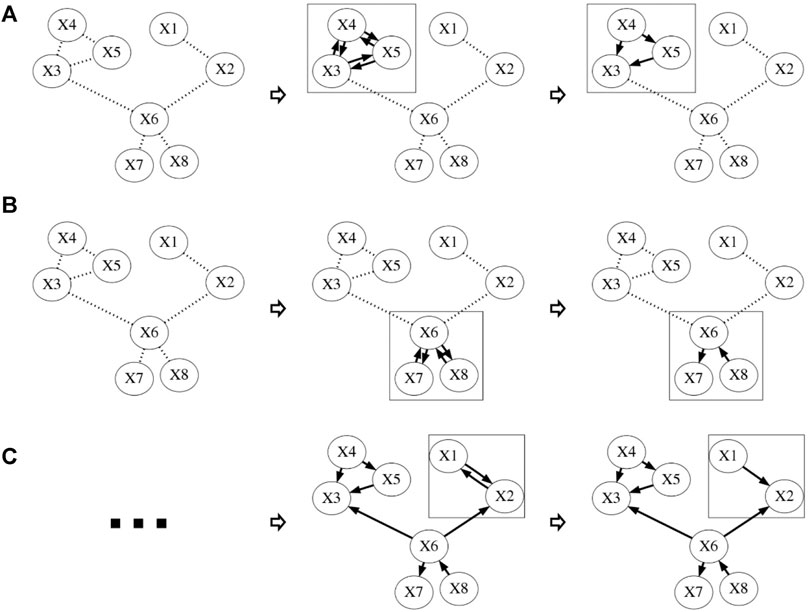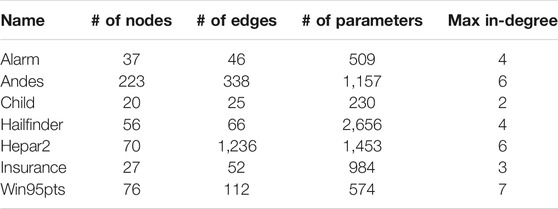- 1Department of Statistics, Florida State University, Tallahassee, FL, United States
- 2Department of Biostatistics and Computational Biology, University of Rochester, Rochester, NY, United States
Bayesian networks (BNs) provide a probabilistic, graphical framework for modeling high-dimensional joint distributions with complex correlation structures. BNs have wide applications in many disciplines, including biology, social science, finance and biomedical science. Despite extensive studies in the past, network structure learning from data is still a challenging open question in BN research. In this study, we present a sequential Monte Carlo (SMC)-based three-stage approach, GRowth-based Approach with Staged Pruning (GRASP). A double filtering strategy was first used for discovering the overall skeleton of the target BN. To search for the optimal network structures we designed an adaptive SMC (adSMC) algorithm to increase the quality and diversity of sampled networks which were further improved by a third stage to reclaim edges missed in the skeleton discovery step. GRASP gave very satisfactory results when tested on benchmark networks. Finally, BN structure learning using multiple types of genomics data illustrates GRASP’s potential in discovering novel biological relationships in integrative genomic studies.
Introduction
A Bayesian network (BN) is a graphical representation of the joint probability distribution of a set of variables (called nodes in the graph). BNs have been widely used in various fields, such as computational biology (Friedman, Linial, Nachman and Pe’er 2000; Raval, Ghahramani and Wild 2002; Vignes, et al., 2011), document classification (Denoyer and Gallinari 2004), and decision support system (Kristensen and Rasmussen 2002). A BN encodes conditional dependencies and independencies (CDIs) among variables into a directed acyclic graph (DAG). And this DAG is called the structure of a BN. When the structure of a BN is given, the parameters that quantify the CDIs can be estimated from observed data. If neither the structure nor parameters are given, they can be inferred from observed data. In this study, we will be focusing on the structure estimation of a BN and its application in learning biological networks using heterogeneous genomics data.
The technical difficulties of structure learning are mainly due to the super-exponential cardinality of the DAG spaces, which are also quite rugged for most commonly used score functions. Estimating the structure exactly is an NP-hard problem (Cooper 1990; Koller and Friedman 2009). There have been many inexact and heuristic methods proposed in the past 2 decades (Zhang, Li, Zhou and Wei 2013; Adabor, Acquaah-Mensah and Oduro 2015; Larjo and Lahdesmaki 2015; Amirkhani, Rahmati, Lucas and Hommersom 2017; Franzin, Sambo and Di Camillo 2017; Han, Zhang, Homayouni and Karmaus 2017; Ferreira-Santos, Monteiro-Soares and Rodrigues 2018; Jabbari, Visweswaran and Cooper 2018; Li and Guo 2018; Tang, Wang, Nguyen and Altintas 2019; Zhang, Wang, Duan and Sun 2019; Zhang, Rodrigues, Narain and Akmaev 2020; Liu, Gao, Wang and Ru 2021). The strategy of these methods can be classified mainly into three categories: constraint-based, score-based, and hybrid, which combines both constraint-based and score-based approaches.
A constraint-based method utilizes the conditional dependency test to identify the conditional dependencies and independencies among all the nodes (Campos 1998; de Campos and Huete 2000; Margaritis 2003; Tsamardinos, Aliferis and Statnikov 2003; Yaramakala and Margaritis 2005; Aliferis, Statnikov, Tsamardinos, Mani and Koutsoukos 2010; Liu, et al., 2021). A major disadvantage of such a method is that a large number of tests have to be conducted; therefore, an appropriate method to adjust the p-values obtained from all the tests have to be applied. The fact that not all the tests are mutually independent further complicates the p-value adjustment. Another issue is that the goodness-of-fit of the obtained network is usually not considered in such an approach; therefore, the estimated BN may not fit the observed data well.
A score-based method uses a score function to evaluate the structures of BNs on observed data (Larrañaga, Poza, Yurramendi, Murga and Kuijpers 1996; Friedman, Nachman and Peér 1999; Gámez, Mateo and Puerta 2011). A searching algorithm is employed to search the best BN (with the highest score) with respect to certain score function. Various Bayesian and non-Bayesian score functions have been proposed in the past. As exact search is not feasible, over the past 2 decades, various heuristic searching methods, such as hill climbing, tabu search, and simulated annealing were proposed to search for the optimal BN structures. The problem with score-based method is that the searching space is often very large and complicated; therefore, the searching algorithm either will take too much time to find the optimum or be trapped in local optima. Many efforts have been made to overcome this challenging issue, such as searching using an ordered DAG space to reduce the searching space (Teyssier and Koller 2012). In the ordered DAG space, the nodes are given an order such that edges will only be searched from higher orders to lower orders. The practical issue is that determining the orders and finding the optimal structure is equally difficult. More recently, various penalty-based methods were proposed to estimate the structures for Gaussian BN (GBN) (Fu and Zhou 2013; Huang, et al., 2013; Xiang and Kim 2013). These methods have been shown to be quite efficient for GBN structure learning and are able to handle structure learning and parameter estimation simultaneously; however, these methods are quite restrictive: the joint distributions must approximately follow a multivariate Gaussian distribution and dependencies among nodes are assumed to be linear.
Hybrid methods which combine a constraint-based method and a score-based method were proposed to combine the advantages of both methods (Tsamardinos, Brown and Aliferis 2006). Such methods often contain two stages: first pruning the searching space by a constraint-based methods, then searching using a score function over the much smaller pruned space. In the pruning stage, the goal is to identify the so-called skeleton of the network, which is the undirected graph of the target DAG. Later in the second stage, the direction of each edge will be determined by optimizing the score function. In a hybrid method, it is important that the first stage identifies as many true undirected edges as possible, since only the identified undirected edges will be considered in the second stage.
In this study, we developed a novel BN structure learning method named GRASP (GRowth-based Approach with Staged Pruning). It is a three-stage method: in stage one, we used a double filtering method to discover a cover of the true skeleton. Unlike the traditional constraint-based methods, which try to obtain the true skeleton exactly, our method only estimates a super set of the undirected edges and it only conditions on at most one node other than the pair of nodes being tested, which dramatically reduces the number of observations needed to make the test results robust. In stage two, we designed an adaptive sequential Monte Carlo (adSMC) (Liu and Chen 1998; Liu 2008) approach to search for a BN structure with optimal score based on constructed skeleton. SMC has been successfully adopted to solve optimization problems in the past (Grassberger 1997; Liang et al., 2002; Zhang and Liu 2002; Zhang et al., 2003; Zhang et al., 2004; Zhang and Liu 2006; Zhang et al., 2007; Zhang et al., 2009). Compared to most greedy searching methods, SMC is less likely to be trapped in local optima. Another advantage of SMC is that it can be run in parallel for each SMC sample, making it suitable for distributed or GPU-based implementations. To further increase the efficiency of the sampling, an adaptive SMC strategy was used to generate higher scored networks. After these two stages, we enhanced the traditional two-stage approach with a third stage which adds possible missed edges back into the network using Random Order Hill Climbing (ROHC).
Methods and Data
GRASP: GRowth-Based Approach With Staged Pruning
GRASP is a three-stage algorithm for learning the structure of a BN. In the first (pruning) stage, we designed a Double Filtering (DF) method to find the cover of the skeleton of the BN, where the skeleton of a BN is defined as the BN structure after removing the direction of all the edges, and the cover is defined as a superset of undirected edges containing all the edges of the skeleton. In the second (structure searching) stage, we developed an adaptive sequential Monte Carlo (adSMC) method to search the BN structure on the undirected network found in the first stage based on Bayesian information criterion (BIC) score. To reclaim the potentially missed edges, we designed a Random Order Hill Climbing (ROHC) method as the third stage.
First Stage: Double Filtering (DF) Method to Infer the Skeleton
The first stage, namely Double Filtering (DF) method, contains two filtering processes. The first filtering was done by unconditioned tests, filtering out the nodes that are not ancestors or descendants of a given node
Suppose we have
1. First filtering. For each pair of nodes (
2. Second filtering. For every node
(a). For every element
(b). For every element
After applying the DF method on all
Second Stage: Structure Searching
In the pruned space, we designed an adaptive sequential Monte Carlo (adSMC) method to search the structure of the Bayesian network. In a traditional sequential Monte Carlo, the random variable of all
For each SMC sample, we start with all possible fully connected triplets (three nodes connected by three undirected edges) discovered in the first stage. We sample one such triplet having the least outside connection, e.g., the one having the least undirected edges connected to its nodes (Figure 1A). These triplets are likely to be restricted to certain configuration by the sampled structure; therefore, to sample them earlier allows more variety in their configurations. When all fully connected triplets are sampled, partially connected triplets (two undirected edges among three nodes) are considered (Figure 1B). Lastly, we consider pairs (the remaining undirected edges, Figure 1C). For partially connected triplets and pairs, the configurations with the least outside connections are sampled first.
The probabilities of possible configurations of triplets and pairs are proportional to their BIC (Bayesian Information Criterion) score defined as
Where
The main algorithm used in the second step is as follows.
Step 1. Sample one fully connected triplet
Step 2. Repeat step 1 until all fully connected triplets are sampled.
Step 3. Sample one partially connected triplet
Step 4. Repeat step 3 until all partially connected triplets are sampled.
Step 5. Sample one pair
Step 6. Repeat step 5 until all pairs are sampled and no more unsampled edges in the skeleton.Since each SMC sample is generated independently, we can run our algorithm in parallel on multiple CPUs/GPU cores to speed up the sampling process.
Third Stage: Reclaiming Missed Edges
We mentioned earlier that one disadvantage of the traditional two-stage method was that the edges missed in the first stage will never be recovered. Therefore, in the third stage we designed a Random Order Hill Climbing (ROHC) method to identify the possible missed edges and refine the network. The general idea is described as follows:
1. Generate a permutation of
2. For every node
3. Repeat (2) until there is no possible edge to add or the searching limit is reached.
One could also view this stage as a further ascent to the local optima to ensure we achieve the best possible BIC score.
In `general, generating more SMC samples gives a higher chance to reach the optimum. However, more samples also require more computation time; therefore, a balance between running time and sample sizes must be made. In most of our simulation study and practical problems, we found that around 20,000 samples were often good enough for finding a network with a satisfactory BIC score.
Performance Evaluation
To measure the effectiveness of edge screening methods, we employed the precision, recall and f-score measurements. Precision is defined as TP/(TP + FP), recall is defined as TP/(TP + FN), and f-score is the harmonic mean of precision and recall, 2 (precision ×
In our study, recall measures the percentage of true edges (irrespective of their directions) identified; therefore, it is the most important measurement in edge screening stage, since as we discussed earlier, any missed edges in stage one may never be reclaimed in a traditional two stage approach. Besides the recall, f-score is also important since it measures a balanced performance in terms of both precision and recall. It is obvious that if we propose all possible edges, we will always identify all true edges, but that will not do any pruning to the searching space. Thus, a high f-score is desired for a decent edge screening strategy.
We used Bayesian Information Criterion (BIC) as the score function in both second stage and third stage. BIC has the score-equivalent property (Appendix definition 10), which can reduce the searching space, since if we could find one network in the equivalent class, we found the true network. And the consistency property of BIC score guarantees that the true network has the highest score asymptotically.
Benchmark Networks
The networks used to generate simulated data (Table 1) are from actual decision making processes of a wide range of real applications including risk management, tech support, and disease diagnosis. All networks are obtained from Bayesian Network Repository maintained by M. Scutari http://www.bnlearn.com/bnrepository/.
We randomly generated data with 1,000, 2,000, and 5,000 observations, and we generated 10 datasets for each size of observations. All results reported in this section are based on averages of 10 datasets. Observation size in this article refers to the number of data points, and shall not be confused with number of sequential Monte Carlo samples. The datasets were generated using R package bnlearn (Scutari 2009; Nagarajan, Scutari and Lèbre 2013).
Real Data
Flow Cytometry Dataset
In the flow cytometry dataset (Sachs, Perez, Pe’er, Lauffenburger and Nolan 2005), there are 11 proteins and phospholipid components of the signaling network. The original data was collected from 7,466 cells, containing continuous variables. Sachs et al. suggested to get rid of the potential outliers by removing data that are three standard deviations away from any attribute. Thus the data we are analyzing contains 6,814 observations. We discretized each variable into three categories, practically stands for high/medium/low, with each category containing 33% of the data.
Genomics and Epigenomics Data From the Cancer Genome Atlas (TCGA)
We used several different types of data obtained from TCGA: RNA-seq, protein expression, DNA methylation, and microRNA-seq, which have been used in our previous studies (Stewart, Luks, Roycik, Sang and Zhang 2013; Li, et al., 2017; Shi, et al., 2017; Li, et al., 2020). These data can be freely downloaded from TCGA data portal (https://portal.gdc.cancer.gov/), which has detailed description on each of the data types.
Results
Edge Screening
The principal of the edge screening stage is pruning the searching space as much as possible while the remaining edges in the pruned space still possess as many true edges as possible. We compare our method to five other methods including max-min parent-child (mmpc) (Tsamardinos, et al., 2006), grow-shrink (gs) (Margaritis 2003), incremental association (iamb) (Tsamardinos, et al., 2003), fast iamb, and inter iamb (Yaramakala, et al., 2005). For all methods, we fixed the significance level (α) to 0.01.
The simulation study results (Figure 2 and Figure S2) showed that our double filtering (DF) method was able to identify the most edges (highest recall) for each of the observation size we tested. In some cases we observed that with even 1,000 observations, our method achieved a higher recall than the other methods using 5,000 observations and the f-scores are still comparable (e.g., Alarm, Hepar2 and etc.). For some networks (Child, Insurance), not only the recalls were higher but also the f-scores were higher for DF. The results confirmed that DF identifies true edges more accurately than other methods and it often requires fewer observations. Higher recall is desired in the first stage (the edge screening stage) since any missed edges will not be sampled in the second stage.
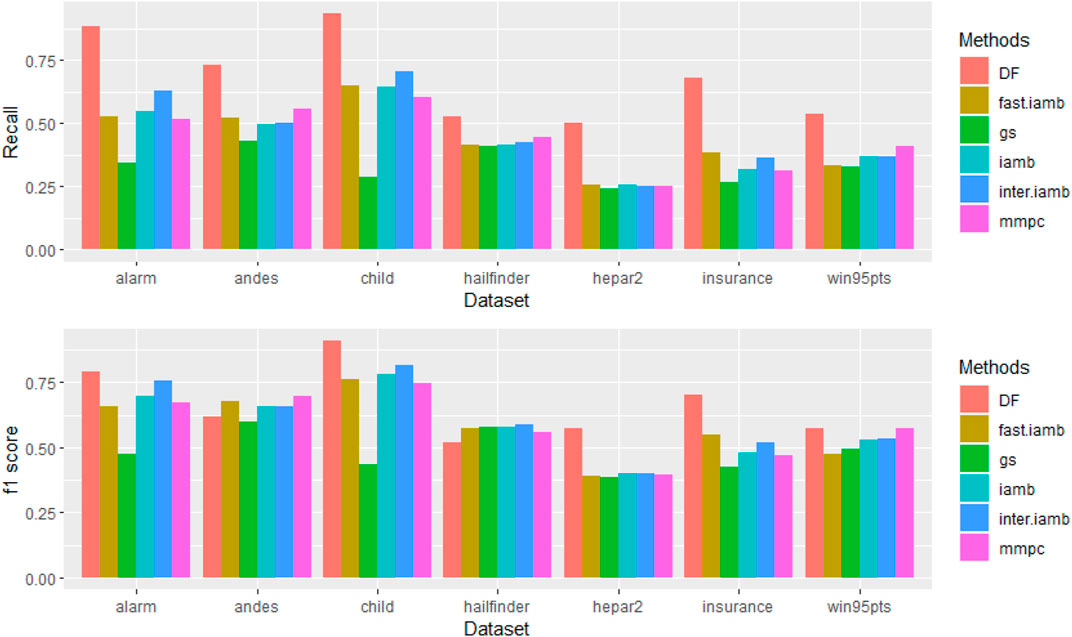
FIGURE 2. Recall and f1 score of different methods with observation size 1,000. One can see that DF generally has higher recalls with higher or comparable F1-scores for the same network.
Effect of Temperature
The temperature parameter in SMC has the same effect as that in MCMC (Markov Chain Monte Carlo) simulations. A lower temperature will cause searching to become greedier, and higher temperatures make it less greedy. When
Effect of Adaptive SMC
To show the improvement of using adaptive SMC, we compared the BICs of 20,000 SMC samples between the adSMC and traditional SMC (Figure S4). In the traditional SMC, we designed the sampling block in the order of fully connected triplets, partially connected triplets and pairs, and started from least outside connected ones. Clearly, the adSMC generates higher scored networks in general.
Effect of the Edge Reclaiming Step
We discussed earlier that there could be some true edges missed in the first stage due to the test power and limited data. Here we will show that Random Order Hill Climbing (ROHC) indeed improves the learned BN structure in stage 2. We used alarm and win95pts networks to illustrate the improvement made by ROHC (Figure S5). They both had significance level cut-off of 0.01, temperature 0.001, and 20,000 SMC samples. As we can see, the improvements were substantial, demonstrating that it is necessary to have the third stage to further refine the learned network. However, one should notice that the complexity level of ROHC is approximately
Performance on Benchmark Networks
We evaluated the overall performance of our method and the general two stage methods (five edge screening methods, gs, mmpc, iamb, fast.iamb, and inter.iamb combined with two optimization methods, Hill climbing and tabu search) on seven benchmark networks. The results are shown in Figure 3 and Supplementary Figure S6 (Supplementary Material). For three different observation sizes, our method outperformed all the general two-stage methods on almost all benchmark networks except on the hepar2 network where all methods achieved similar scores, which are very close to the BIC of the true network.
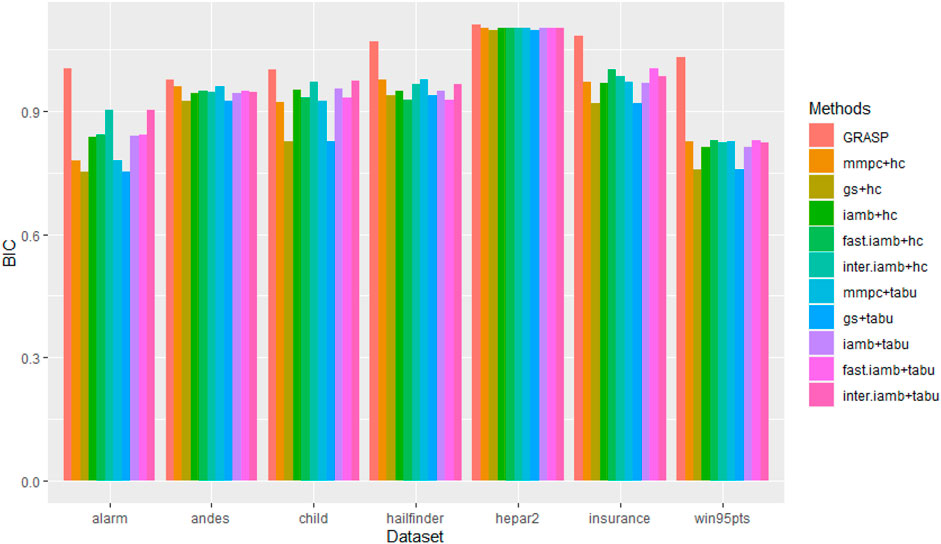
FIGURE 3. BIC scores of all methods on seven benchmark networks with observation size 1,000. GRASP has higher BIC scores for all the benchmark networks.
Performance on the Flow Cytometry Data
We first compared our method to the general 2-stage methods and the CD method (Fu, et al., 2013) on the flow cytometry data. GRASP achieved the highest BIC score (Figure 4), which is consistent with the simulation study.
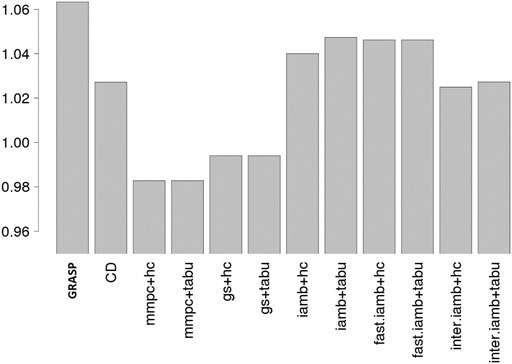
FIGURE 4. BIC scores for the flow cytometry data, comparing 12 methods, and GRASP has the highest BIC score. The y-axis value is the ratio of the BIC score of the sampled network and the true network. It is possible that a sampled network has even higher BIC score than the true network, hence the value can be higher than 1.
An Integrative Genomic Study Using TCGA Data
An advantage of BN models is that they can handle heterogeneous data well. In this section, we will test our method using a heterogeneous genomics dataset from TCGA through learning network structures that may shed light on real biological problems. In a previous study of ours (Stewart, et al., 2013), we have identified a long non-coding RNA, LOC90784, which is strongly associated with breast cancer health disparity between African American and Caucasian American breast cancer patients. However, literature search resulted in no information about it since it had not been studied by any researchers in the past. Using several different types of genomics data, we applied GRASP to perform an integrative study to build a Bayesian network with different genomics features to shed some light on the function of this transcript. All the data were first discretized into a small number of categories, usually 2–4. We first used RNA-seq data to identify transcripts highly correlated with LOC90784. This gave us eight transcripts with absolute value of correlation coefficient greater than 0.27. We then found other genomic features, including microRNAs, DNA methylations and protein expressions that are highly correlated with these transcripts, which gave us 13 microRNAs, 5 DNA methylation regions (aggregated around genes) and five proteins. Using the samples with all the above measurements, we inferred the BN structure for these genomics features as shown in Figure 5. As a comparison, bnlearn, a R package for BN structure learning, gave a network without LOC90784 (Supplementary Figure S7). Figure 5 showed rather complex relationships among all these genomic features. A thorough investigation of this network is beyond the scope of this work. However, some literature search on the nodes around LOC90784 provided interesting hypotheses, which could be followed up with experiments. Specifically, TET3, an upstream gene, was found to inhibit TGF-β1-induced epithelial-mesenchymal transition in ovarian cancer cells (Ye, et al., 2016). High frequency of PIK3R2 mutations in endometrial cancer was found to be related to the regulation of protein stability of PTEN (Cheung, et al., 2011), which is a well-known cancer related gene. There are not a lot of published studies on IRGQ. From the Human Protein Atlas database (https://www.proteinatlas.org/ENSG00000167378-IRGQ/pathology) we found that this gene is a prognostic biomarker and significant for survival for several cancer types including pancreatic cancer, renal cancer, cervical cancer and liver cancer. It would be interesting to see how perturbations of TET3, PIK3R2, such as knockdown/knockout experiments, affect LOC90784 and how perturbation of LOC90784 affects IRGQ. These hypotheses demonstrated the potential of GRASP for discovering new biology through integrative genomic studies.
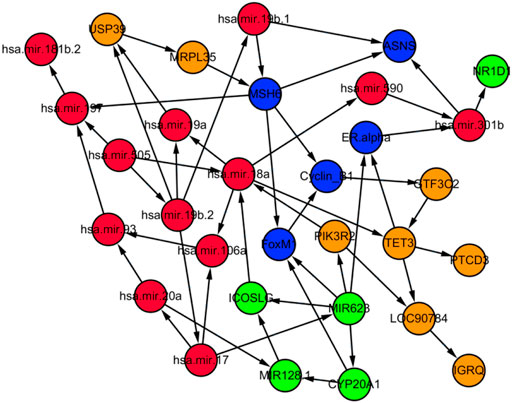
FIGURE 5. The BN structure learned by GRASP using multiple different genomic features which are highly correlated with the expression of LOC90784. Orange nodes: mRNA transcripts; Red nodes: microRNAs; Blue nodes: protein expressions; Green nodes: DNA methylations.
Discussion
In this study, we developed a three-stage Bayesian network structure learning method, GRASP. The first stage is an edge screening method, Double Filtering, which recovers a super set of true edges and proposes as few edges as possible. The second stage is an adaptive SMC (adSMC) approach to optimize a score function (BIC in this study) that measures the fitness of a BN structure to the given data. To reclaim the possible missed edges from the first two stages, we developed a random order hill climbing method (ROHC) to recover the missed edges as the last stage. The principal of double filtering is quite different from the well-known mmpc method or other similar constraint-based methods, where the algorithm is trying to identify the skeleton of the BN (undirected true edges). Double filtering method focuses on identifying a set of undirected edges that contains all the true edges, at the same time tries to propose as few edges as possible. The advantage of mmpc is that given enough observations it identifies the true network skeleton; however, it may not be feasible when the observations are limited since mmpc conducts conditional dependency test conditioning on all previously identified dependent (connected) nodes, and it requires more observations when the number of conditioned nodes increases. On the other hand, double filtering only conditions on one node at a time, so the required observation size can be much smaller.
The adSMC approach in structure sampling stage can find better BN structure than greedy searching algorithms or traditional SMC. The algorithm takes into account the currently sampled partial BN structures to make more informed decisions on the sampling of new edges. In addition, adSMC sampling is completely parallelizable, and multiple CPUs/GPU implementations will likely further improve the computational efficiency substantially.
Although in this study we focused on categorical variables (nodes) with multinomial distribution, one may extend our approach to other types of variables including Gaussian ones, as long as all nodes have the same distribution and the local conditional distribution can be estimated. Imposing distributions that are easier to be estimated on the nodes will in general make the searching more efficient. Practically, it is not an easy task to find appropriate distribution for all nodes. For BNs with mixed node types, where nodes do not necessarily have the same distribution, our method could handle them indirectly by discretizing the observations making each node distributed as multinomial distribution.
The application of GRASP on heterogeneous genomics data showed its potential to infer complex biological networks, which may shed light on the functions of unknown genes or epigenetic features. The learned structures of BN also provide guidance on formulating specific hypotheses that can be tested experimentally.
Data Availability Statement
Publicly available datasets were analyzed in this study. Benchmark Bayesian networks can be found at: https://www.bnlearn.com/bnrepository/. Genomics data analyzed can be found at: https://portal.gdc.cancer.gov/.
Author Contributions
KY designed the study, performed the research, analyzed the results, and wrote the paper; ZC analyzed the results, XS analyzed the results, XQ revised the paper, JZ designed the study and wrote the paper.
Funding
This work was supported by the National Institute of General Medical Sciences of the National Institutes of Health under award number R01GM126558. The funders had no role in study design, data collection and analysis, decision to publish, or preparation of the manuscript.
Conflict of Interest
The authors declare that the research was conducted in the absence of any commercial or financial relationships that could be construed as a potential conflict of interest.
Publisher’s Note
All claims expressed in this article are solely those of the authors and do not necessarily represent those of their affiliated organizations, or those of the publisher, the editors and the reviewers. Any product that may be evaluated in this article, or claim that may be made by its manufacturer, is not guaranteed or endorsed by the publisher.
Supplementary material
The supplementary material for this article can be found online at: https://www.frontiersin.org/articles/10.3389/fgene.2021.764020/full#supplementary-material
References
Adabor, E. S., Acquaah-Mensah, G. K., and Oduro, F. T. (2015). Saga: A Hybrid Search Algorithm for Bayesian Network Structure Learning of Transcriptional Regulatory Networks. J. Biomed. Inform. 53, 27–35. doi:10.1016/j.jbi.2014.08.010
Aliferis, C. F., Statnikov, A., Tsamardinos, I., Mani, S., and Koutsoukos, X. D. (2010). Local Causal and Markov Blanket Induction for Causal Discovery and Feature Selection for Classification Part I: Algorithms and Empirical Evaluation. J. Mach. Learn. Res. 11, 171–234. doi:10.1145/175600.61756013
Amirkhani, H., Rahmati, M., Lucas, P. J. F., and Hommersom, A. (2017). Exploiting Experts' Knowledge for Structure Learning of Bayesian Networks. IEEE Trans. Pattern Anal. Mach. Intell. 39, 2154–2170. doi:10.1109/tpami.2016.2636828
Campos, L. M. d., and Campos, L. M. d. (1998). Independency Relationships and Learning Algorithms for Singly Connected NetworksA Scoring Function for Learning Bayesian Networks Based on Mutual Information and Conditional Independence Tests. J. Machine Learn. Res. 7, 2149–2187. doi:10.1080/095281398146743
Cheung, L. W. T., Hennessy, B. T., Li, J., Yu, S., Myers, A. P., Djordjevic, B., et al. (2011). High Frequency of Pik3r1 and Pik3r2 Mutations in Endometrial Cancer Elucidates a Novel Mechanism for Regulation of Pten Protein Stability. Cancer Discov. 1, 170–185. doi:10.1158/2159-8290.cd-11-0039
Cooper, G. F. (1990). The Computational Complexity of Probabilistic Inference Using Bayesian Belief Networks. Artif. Intelligence 42, 393–405. doi:10.1016/0004-3702(90)90060-d
de Campos, L. M., and Huete, J. F. (2000). A New Approach for Learning Belief Networks Using Independence Criteria. Int. J. Approximate Reasoning 24, 11–37. doi:10.1016/s0888-613x(99)00042-0
Denoyer, L., and Gallinari, P. (2004). Bayesian Network Model for Semi-structured Document Classification. Inf. Process. Manage. 40, 807–827. doi:10.1016/j.ipm.2004.04.009
Ferreira-Santos, D., Monteiro-Soares, M., and Rodrigues, P. P. (2018). Impact of Imputing Missing Data in Bayesian Network Structure Learning for Obstructive Sleep Apnea Diagnosis. Stud. Health Technol. Inform. 247, 126–130.
Franzin, A., Sambo, F., and Di Camillo, B. (2017). Bnstruct: An R Package for Bayesian Network Structure Learning in the Presence of Missing Data. Bioinformatics 33, 1250–1252. doi:10.1093/bioinformatics/btw807
Friedman, N., Linial, M., Nachman, I., and Pe'er, D. (2000). Using Bayesian Networks to Analyze Expression Data. J. Comput. Biol. 7, 601–620. doi:10.1089/106652700750050961
Friedman, N., Nachman, I., and Peér, D. (1999). “Learning Bayesian Network Structure from Massive Datasets: The «Sparse Candidate «Algorithm”, In. Proceedings of the Fifteenth conference on Uncertainty in artificial intelligence, 30 July 1999, Stockholm, Sweden, Morgan Kaufmann Publishers Inc., 206–215.
Fu, F., and Zhou, Q. (2013). Learning Sparse Causal Gaussian Networks with Experimental Intervention: Regularization and Coordinate Descent. J. Am. Stat. Assoc. 108, 288–300. doi:10.1080/01621459.2012.754359
Gámez, J. A., Mateo, J. L., and Puerta, J. M. (2011). Learning Bayesian Networks by Hill Climbing: Efficient Methods Based on Progressive Restriction of the Neighborhood. Data Min Knowl Disc 22, 106–148. doi:10.1007/s10618-010-0178-6
Grassberger, P. (1997). Pruned-enriched Rosenbluth Method: Simulations Ofθpolymers of Chain Length up to 1 000 000. Phys. Rev. E 56, 3682–3693. doi:10.1103/physreve.56.3682
Han, S., Zhang, H., Homayouni, R., and Karmaus, W. (2017). An Efficient Bayesian Approach for Gaussian Bayesian Network Structure Learning. Commun. Stat. - Simulation Comput. 46, 5070–5084. doi:10.1080/03610918.2016.1143103
Huang, S., Li, J., Ye, J., Fleisher, A., Chen, K., Wu, T., et al. (2013). A Sparse Structure Learning Algorithm for Gaussian Bayesian Network Identification from High-Dimensional Data. IEEE Trans. Pattern Anal. Mach. Intell. 35, 1328–1342. doi:10.1109/tpami.2012.129
Jabbari, B., Visweswaran, S., and Cooper, G. F. (2018). Botulinum Toxin Treatment in Children. Proc. Mach Learn. Res. 72, 169–180. doi:10.1007/978-3-319-99945-6_14
Koller, D., and Friedman, N. (2009). Probabilistic Graphical Models: Principles and Techniques. Cambridge, MA: MIT Press.
Kristensen, K., and Rasmussen, I. A. (2002). The Use of a Bayesian Network in the Design of a Decision Support System for Growing Malting Barley without Use of Pesticides. Comput. Electro. Agric. 33, 197–217. doi:10.1016/s0168-1699(02)00007-8
Larjo, A., and Lähdesmäki, H. (2015). Using Multi-step Proposal Distribution for Improved Mcmc Convergence in Bayesian Network Structure Learning. EURASIP J. Bioinform Syst. Biol. 2015, 6. doi:10.1186/s13637-015-0024-7
Larrañaga, P., Poza, M., Yurramendi, Y., Murga, R. H., and Kuijpers, C. M. H. (1996). Structure Learning of Bayesian Networks by Genetic Algorithms: A Performance Analysis of Control Parameters. IEEE Trans. Pattern Anal. Machine Intell. 18, 912–926. doi:10.1109/34.537345
Liang, J., Zhang, J., and Chen, R. (2002). Statistical Geometry of Packing Defects of Lattice Chain Polymer from Enumeration and Sequential Monte Carlo Method. J. Chem. Phys. 117, 3511–3521.
Li, H., and Guo, H. (2018). A Hybrid Structure Learning Algorithm for Bayesian Network Using Experts' Knowledge. Basel): Entropy, 20.
Li, Y., Steppi, A., Zhou, Y., Mao, F., Miller, P. C., He, M. M., et al. (2017). Tumoral Expression of Drug and Xenobiotic Metabolizing Enzymes in Breast Cancer Patients of Different Ethnicities with Implications to Personalized Medicine. Sci. Rep. 7, 4747. doi:10.1038/s41598-017-04250-2
Liu, J. S., and Chen, R. (1998). Sequential Monte Carlo Methods for Dynamic Systems. J. Am. Stat. Assoc. 93, 1032–1044. doi:10.1080/01621459.1998.10473765
Liu, X., Gao, X., Wang, Z., and Ru, X. (2021). Improved Local Search with Momentum for Bayesian Networks Structure Learning. Basel): Entropy, 23
Raval, A., Ghahramani, Z., and Wild, D. L. (2002). A Bayesian Network Model for Protein Fold and Remote Homologue Recognition. Bioinformatics 18, 788–801. doi:10.1093/bioinformatics/18.6.788
Sachs, K., Perez, O., Pe'er, D., Lauffenburger, D. A., and Nolan, G. P. (2005). Causal Protein-Signaling Networks Derived from Multiparameter Single-Cell Data. Science 308, 523–529. doi:10.1126/science.1105809
Scutari, M. (2009). Learning Bayesian Networks with the Bnlearn R Package. arXiv preprint arXiv:0908.3817
Shi, Y., Steppi, A., Cao, Y., Wang, J., He, M. M., Li, L., et al. (2017). Integrative Comparison of Mrna Expression Patterns in Breast Cancers from Caucasian and Asian Americans with Implications for Precision Medicine. Cancer Res. 77, 423–433. doi:10.1158/0008-5472.can-16-1959
Stewart, P. A., Luks, J., Roycik, M. D., Sang, Q. X., and Zhang, J. (2013), Differentially Expressed Transcripts and Dysregulated Signaling Pathways and Networks in African American Breast Cancer, PLoS One 8. e82460. doi:10.1371/journal.pone.0082460
Tang, Y., Wang, J., Nguyen, M., and Altintas, I. (2019), Penbayes: A Multi-Layered Ensemble Approach for Learning Bayesian Network Structure from Big Data, 19 Sensors (Basel), 20. 4400. doi:10.3390/s19204400
Teyssier, M., and Koller, D. (2012). Ordering-Based Search: A Simple and Effective Algorithm for Learning Bayesian Networks. arXiv preprint arXiv:1207.1429
Tsamardinos, I., Aliferis, C. F., and Statnikov, A. (2003). “Time and Sample Efficient Discovery of Markov Blankets and Direct Causal Relations”, In. Proceedings of the Ninth ACM SIGKDD International Conference on Knowledge Discovery and Data Mining, 24 August 2003, Washington, D.C.US, Association for Computing Machinery, 673–678. doi:10.1145/956750.956838
Tsamardinos, I., Brown, L. E., and Aliferis, C. F. (2006). The Max-Min Hill-Climbing Bayesian Network Structure Learning Algorithm. Mach Learn. 65, 31–78. doi:10.1007/s10994-006-6889-7
Vignes, M., Vandel, J., Allouche, D., Ramadan-Alban, N., Cierco-Ayrolles, C., Schiex, T., et al. (2011). Gene Regulatory Network Reconstruction Using Bayesian Networks, the Dantzig Selector, the Lasso and Their Meta-Analysis. PLoS ONE 6, e29165. doi:10.1371/journal.pone.0029165
Xiang, J., and Kim, S. (2013). A\\Ast Lasso for Learning a Sparse Bayesian Network Structure for Continuous Variables, 2418–2426.
Yaramakala, S., and Margaritis, D. (2005).”Speculative Markov Blanket Discovery for Optimal Feature Selection”, In. Proceedings of the Data mining, fifth IEEE international conference on, 27 November 2005, NW Washington, DC, United States. IEEE, 4 .
Yan, L., Xiaodong, P., Zihan, C., Yidong, Z., Feng, M., Yan, L., et al. (2020). Genetic Factors Associated with Cancer Racial Disparity - an Integrative Study across Twenty-One Cancer Types. Mol. Oncol. 14.
Ye, Z., Li, J., Han, X., Hou, H., Chen, H., Zheng, X., et al. (2016). TET3 Inhibits TGF-Β1-Induced Epithelial-Mesenchymal Transition by Demethylating miR-30d Precursor Gene in Ovarian Cancer Cells. J. Exp. Clin. Cancer Res. 35, 72. doi:10.1186/s13046-016-0350-y
Zhang, J., Chen, R., Tang, C., and Liang, J. (2003). Origin of Scaling Behavior of Protein Packing Density: A Sequential Monte Carlo Study of Compact Long Chain Polymers. J. Chem. Phys. 118 (13), 6102–6109.
Zhang, J., Chen, Y., Chen, R., and Liang, J. (2004). Importance of Chirality and Reduced Flexibility of Protein Side Chains: A Study with Square and Tetrahedral Lattice Models. J. Chem. Phys. 121, 592–603.
Zhang, J., Lin, M., Chen, R., Liang, J., and Liu, J. S. (2007). Monte Carlo Sampling of Near-Native Structures of Proteins with Applications. Proteins 66, 61–68. doi:10.1002/prot.21203
Zhang, J., and Liu, J. S. (2006). On Side-chain Conformational Entropy of Proteins. PLoS Comput. Biol. 2 (12), e168. doi:10.1371/journal.pcbi.0020168
Zhang, J., Dundas, J., Lin, M., Chen, R., Wang, W., and Liang, J. (2009). Prediction of Geometrically Feasible Three-Dimensional Structures of Pseudoknotted Rna through Free Energy Estimation. Rna 15, 2248–2263. doi:10.1261/rna.1723609
Zhang, J. L., and Liu, J. S. (2002). A New Sequential Importance Sampling Method and its Application to the Two-Dimensional Hydrophobic-Hydrophilic Model. J. Chem. Phys. 117, 3492–3498. doi:10.1063/1.1494415
Zhang, L., Rodrigues, L. O., Narain, N. R., and Akmaev, V. R. (2020). Baicis: A Novel Bayesian Network Structural Learning Algorithm and its Comprehensive Performance Evaluation against Open-Source Software. J. Comput. Biol. 27, 698–708. doi:10.1089/cmb.2019.0210
Zhang, Q., Li, Z., Zhou, C. J., and Wei, X. P. (2013). Bayesian Network Structure Learning Based on the Chaotic Particle Swarm Optimization Algorithm. Genet. Mol. Res. 12, 4468–4479. doi:10.4238/2013.october.10.12
Keywords: Bayesian network, Bayesian network structure learning, sequential Monte Carlo, adaptive sequential Monte Carlo, GRASP for BN structure learning, biological network inference
Citation: Yu K, Cui Z, Sui X, Qiu X and Zhang J (2021) Biological Network Inference With GRASP: A Bayesian Network Structure Learning Method Using Adaptive Sequential Monte Carlo. Front. Genet. 12:764020. doi: 10.3389/fgene.2021.764020
Received: 24 August 2021; Accepted: 25 October 2021;
Published: 29 November 2021.
Edited by:
Yong He, Shandong University, ChinaReviewed by:
Hao Chen, Peking University, ChinaXin Liu, Shanghai University of Finance and Economics, China
Copyright © 2021 Yu, Cui, Sui, Qiu and Zhang. This is an open-access article distributed under the terms of the Creative Commons Attribution License (CC BY). The use, distribution or reproduction in other forums is permitted, provided the original author(s) and the copyright owner(s) are credited and that the original publication in this journal is cited, in accordance with accepted academic practice. No use, distribution or reproduction is permitted which does not comply with these terms.
*Correspondence: Jinfeng Zhang, amluZmVuZ0BzdGF0LmZzdS5lZHU=; Kaixian Yu, a2FpeGlhbnlAZ21haWwuY29t
 Kaixian Yu
Kaixian Yu Zihan Cui1
Zihan Cui1 Xing Qiu
Xing Qiu Jinfeng Zhang
Jinfeng Zhang